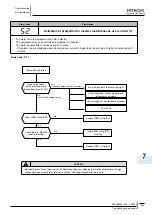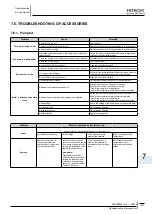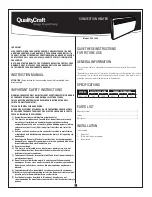
219
Checking procedure for main parts
SMGB0066 rev.0 - 12/2009
Troubleshooting
Service Manual
7
Touch [+] of the tester to [P] of DIP-IPM (soldered
5.
part), and [-] to DIP-IPM U, V, W terminals to measure
the resistance.
Normal if all three terminals have 1 kΩ or greater.
Contrary to [5], touch [-] of the tester to [P] of DIP-IPM
6.
(soldered part), and [+] to DIP-IPM U, V, W terminals
to measure the resistance.
Normal if all three terminals have 30 kΩ or greater.
(Resistance gradually increases during measurement.)
Touch [-] of the tester to [N] of ISPM (soldered part),
7.
and [+] to ISPM U, V, W terminals to measure the
resistance.
Normal if all three terminals have 1 kΩ or greater.
Contrary to [7], touch [+] of the tester to [N] ofDIP-IPM
8.
(soldered part), and [-] to DIP-IPM U, V, W terminals to
measure the resistance.
Normal if all three terminals have 30 kΩ or greater.
(Resistance gradually increases during measurement.)
Internal circuit of ACT part of inverter module
Non-faulty if [9] – [13] are checked and satisfied.
(Measure with 1 kΩ range of a tester.)
note
DO NOT use a digital tester
-
Check items [1] – [8].
9.
Touch [+] of the tester to DIP-IPM DCL2 terminal, and
10.
[-] to [P] of ISPM/DIP-IPM (soldered part) to measure
the resistance.
Normal if all three terminals have 100 kΩ or greater
Contrary to [10], touch [-] of the tester to DIP-IPM
11.
DCL2 terminal, and [+] to [P] of DIP-IPM (soldered
part) to measure the resistance.
Normal if all three terminals have 1 kΩ or greater.
Touch [+] of the tester to DIP-IPM DCL2 terminal, and
12.
[-] to [N] of DIP-IPM (soldered part) to measure the
resistance.
Normal if all three terminals have 100 kΩ or greater.
Contrary to [12], touch [-] of the tester to DIP-IPM
13.
DCL2 terminal, and [+] to [N] of DIP-IPM (soldered
part) to measure the resistance.
Normal if all three terminals have 10 kΩ or greater.
(Resistance gradually increases during measurement.)
Contact with specified terminals
to measure.
Tester
Contact with specified terminals
to measure.
Tester
External Appearance and Internal
Circuit of Transistor Module
















































